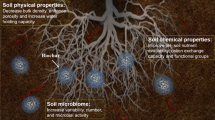Abstract
Aerobic composting is a method for the sanitary disposal of human feces as is used in bio-toilet systems. As the products of composting can be utilized as a fertilizer, it would be beneficial if the composting conditions could be more precisely controlled for the retention of fecal nitrogen as long as possible in the compost. In this study, batch experiments were conducted using a closed aerobic thermophilic composting reactor with sawdust as the bulk matrix to simulate the condition of a bio-toilet for the sanitary disposal of human feces. Attention was paid to the characteristics of nitrogen transformation. Under the controlled conditions of temperature at 60°C, moisture content at 60%,anda continuous air supply, more than 70% fecal organic removal was obtained, while merely 17% fecal nitrogen loss was observed over a two-week composting period. The nitrogen loss was found to occur mainly in the first 24 h with the rapid depletion of inorganic nitrogen but with an almost unchanged organic nitrogen content. The fecal NH4-N which was the main component of the inorganic nitrogen ( > 90%) decreased rapidly in the first day, decreased at a slower rate over the following days, and finally disappeared entirely. The depletion of NH4-N was accompanied by the accumulation of NH3 gas in the ammonia absorber connected to the reactor. A mass balance between the exhausted NH3 gas and the fecal NH4-N content in the first 24 hours indicated that the conversion of ammonium into gaseous ammonia was the main reason for nitrogen loss. Thermophilic composting could be considered as a way to keep a high organic nitrogen content in the compost for better utilization as a fertilizer.
Similar content being viewed by others
References
Zavala M A L, Funamizu N. Design and operation of the bio-toilet system. Water Science and Technology, 2006, 53(9): 55–61
Wang X C, Jin P K. Water shortage and needs for wastewater re-use in the north China. Water Science and Technology, 2006, 53(9): 35–44
Kitsui T, Terazawa M. Bio-toilet, Environmentally friendly toilets for the 21st century. In: Proceedings of the 10th International Symposium on Wood and Pulping Chemistry (ISWPC) 1999, Yokohama, Japan. 1999, 120–121
Zavala M A L, Funamizu N, Takakuwa T. Temperature effect on aerobic biodegradation of feces using sawdust as a matrix. Water Research, 2004, 38(9): 2406–2416
Hanajima D, Kuroda K, Fukumoto Y, Haga K. Effect of addition of organic waste on reduction of Escherichia coli during cattle feces composting under high-moisture condition. Bioresource Technology, 2006, 97(14): 1626–1630
Vinnerås B. Comparison of composting, storage and urea treatment for sanitising of faecal matter and manure. Bioresource Technology, 2007, 98(17): 3317–3321
Wang H B, Wang X C. Evaluation on the effect of human feces composting in new type composting reactor. Chinese Journal of Environmental Engineering, 2008, 2(1): 97–100 (in Chinese)
Eklind Y, Kirchmann H. Composting and storage of organic household waste with different litter amendments I: carbon turnover. Bioresource Technology, 2000, 74(2): 115–124
Eklind Y, Kirchmann H. Composting and storage of organic household waste with different litter amendments. II: nitrogen turnover and losses. Bioresource Technology, 2000, 74(2): 125–133
Sánchez-Monedero M A, Roig A, Paredes C, Bernal M P. Nitrogen transformation during organic waste composting by the Rutgers system and its effects on pH, EC and maturity of the composting mixtures. Bioresource Technology, 2001, 78(3): 301–308
Wang H B, Wang X C. Variation characteristics of sawdust as matrix in human feces composting reactor and its effect on microorganisms. Environmental Science & Technology, 2009, 32(3): 122–125 (in Chinese)
Zavala M A, Funamizu N, Takakuwa T. Biological activity in the composting reactor of the bio-toilet system. Bioresource Technology, 2005, 96(7): 805–812
Hotta S, Noguchi T, Funamizu N. Experimental study on nitrogen components during composting process of feces. Water Science and Technology, 2007, 55(7): 181–186
Hotta S, Funamizu N. Biodegradability of fecal nitrogen in composting process. Bioresource Technology, 2007, 98(17): 3412–3414
Huang G F, Wong J W, Wu Q T, Nagar B B. Effect of C/N on composting of pig manure with sawdust. Waste Management (New York NY), 2004, 24(8): 805–813
Zhu N W. Effect of low initial C/N ratio on aerobic composting of swine manure with rice straw. Bioresource Technology, 2007, 98(1): 9–13
Wang H B, Sun Y, Wang X C. A study on the characteristic features of feces decomposition by using sawdust as microbial carrier for an aerobic compositing reactor. Journal of Safety and Environment, 2008, 8(2): 43–46 (in Chinese)
Tiquia S M, Tam N F, Hodgkiss I J. Effects of composting on phytotoxicity of spent pig-manure sawdust litter. Environmental Pollution, 1996, 93(3): 249–256
National General Administration of Environmental Protection, Standard Method for the Examination of Water and Wastewater Editing Board. Methods for Monitoring and Analysis of Water and Wastewater, Standard Method for the Examination of Water and Wastewater. 4th ed. Beijing: Environmental Science Press of China, 2002 (in Chinese)
National General Administration of Environmental Protection. Water quality—Determination of the chemical oxygen demand—Fast digestion-spectrophotometric method (HT/J 399-2007). Beijing: Environmental Science Press of China, 2007 (in Chinese)
Chen J, Wu Y H. Alkaline potassium persulfate digestion determination of total nitrogen in municipal sludge. The Administration and Technique of Environmental Monitoring, 2005, 17(1): 35–37 (in Chinese)
Vitousek P M, Aber J D, Howarth R W, Likens G E, Matson P A, Schindler D W, Schlesinger H W, Tilman D G. Human alteration of the global nitrogen cycle: sources and consequences. Ecological Applications, 1997, 7(3): 737–750
Author information
Authors and Affiliations
Corresponding author
Rights and permissions
About this article
Cite this article
Bai, F., Wang, X. Nitrogen-retaining property of compost in an aerobic thermophilic composting reactor for the sanitary disposal of human feces. Front. Environ. Sci. Eng. China 4, 228–234 (2010). https://doi.org/10.1007/s11783-010-0022-7
Received:
Accepted:
Published:
Issue Date:
DOI: https://doi.org/10.1007/s11783-010-0022-7




